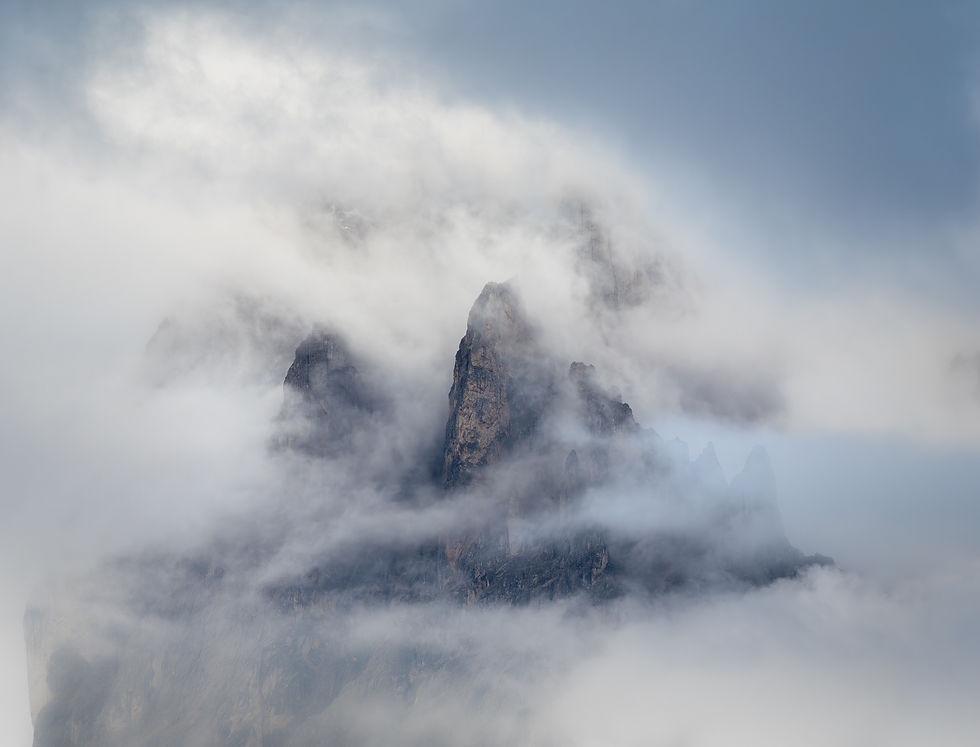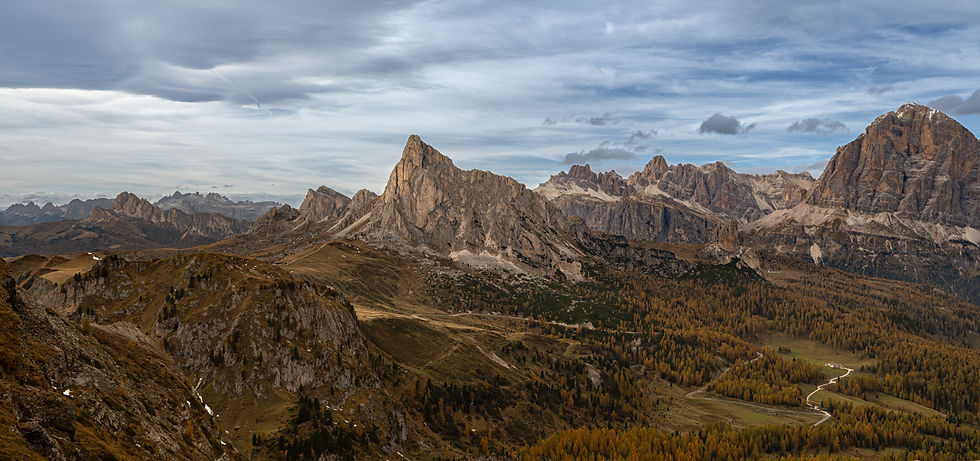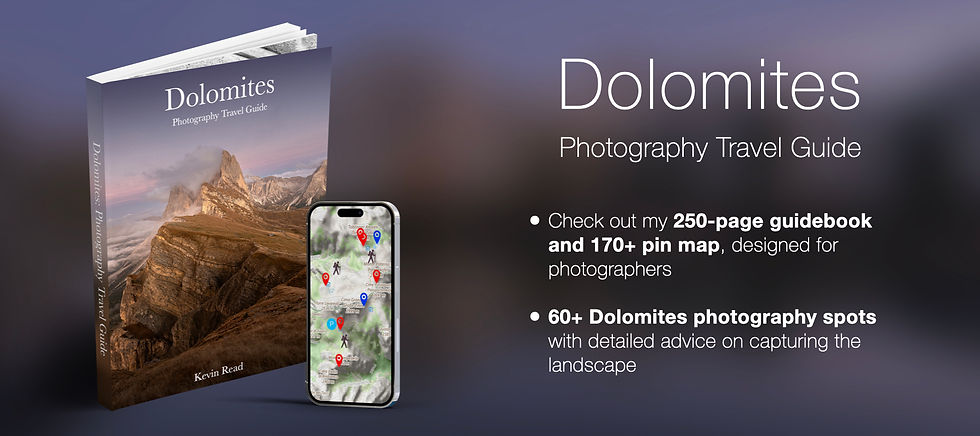Dolomites Photography and Travel Advice
- Kevin Read

- Jul 13
- 6 min read
Updated: Sep 10
This article is part of the Complete Guide to Photography in the Dolomites

With the right approach, timing, and a bit of luck, you can capture an incredible set of photographs even with a single visit to the Dolomites. The landscape has so much variety that you can capture everything from rugged mountain peaks to open green valleys, with stunning alpine lakes scattered at every altitude.
However, shooting any mountain destination has its challenges, and it’s important to understand how photography in the Dolomites works. A successful photography trip isn't just about knowing where to go, it’s about understanding how to navigate and capture the mountains.
Your planning and approach to photography in the Dolomites will have a huge impact on the images you capture, and you may need to adapt how you travel and shoot in the mountains. This article contains my best advice for getting the most from a photography trip to the Dolomites.
Be driven by the weather

One of the great challenges of photography is making each place work in whatever conditions you find on location. A good photographer can adapt their style to the weather, and sometimes an unexpected change in conditions can force us to be more creative with our compositions.
However, mountain weather can be extreme, and a bad day can be extremely difficult while a good day can be extraordinary. Forecasting and reacting to the weather is important when exploring remote and high-altitude locations, and you’ll need to pay attention to the conditions whenever you set out for a mountain peak or start a long hike.
It’s easy to become too obsessed with the forecast when out with the camera, and the weather in the mountains is so changeable that you can only plan so far. However, it’s frustrating to photograph a peak lost to heavy cloud or a lake constantly whipped up by the wind, and you’ll have much more success in the Dolomites if you can let the weather make most of the decisions about which spots to visit each day.
Make your itinerary flexible

To be driven by the weather, we need a flexible itinerary. If you carefully plan each day of your trip to the Dolomites and arrange accommodation close to every spot you want to visit, you’ll often find yourself in the wrong place for the conditions. Instead, it’s best to arrange a trip with a central base, staying in the same place for many days at a time and adapting each day to the forecast.
You can expect that any trip to the mountains will have some days of heavy cloud and rain, and some spectacular clear skies and amazing light. By staying in a single place, you can make better choices about which locations you visit in which conditions, and prioritise your favourite spots based on the light.
You can always make use of difficult weather in the Dolomites, and some locations work better with a brooding sky and heavy cloud. However, many of the most striking spots look their best with a beautiful sunrise or dappled midday light. Arranging a flexible itinerary will allow you to make a better plan that adapts to the weather during your journey.
Plan each journey carefully

A photography shoot in the Dolomites involves a little more planning than identifying a good spot, picking the best time and conditions, and arriving on location. Some spots require a long hike to reach, and others can have restricted parking or road access during busy seasons. Getting around the mountains involves more logistics than you may be used to, and understanding how to reach the locations you plan to shoot will be a big part of the journey.
There is great infrastructure in the Dolomites, and people have been visiting the area for outdoor activities for a very long time. Most of the great photography locations in these mountains are easy to reach for anyone with a good level of health and fitness, and some are accessible to everyone.
However, it’s very easy to plan a shoot for sunrise and forget to factor in a 300-metre elevation hike, or find a great spot online only to discover when you arrive that you’ll need to devote most of a day to reach it. Even if you are used to researching places to visit with the camera, it’s worth paying more attention to hiking and altitude factors when shooting in the Dolomites.
Time your visit carefully

You can visit the Dolomites at any time of year, and the landscape changes radically with the seasons. The Dolomites are a popular hiking destination in summer, with fields of wildflowers, forested hillsides, and dramatic peaks to explore. In winter, the region becomes a major ski destination, and you can access many mountaintop locations even in heavy snow.
However, the conditions change so completely that the timing of your trip will have a huge effect on your experience. July and August are peak hiking season, where you’ll be able to explore the full landscape, but also have to navigate the crowds at popular locations. October is best for autumn colours, but hotels and restaurants start to close for the season if you arrive too late.
There is a detailed breakdown of the best times to visit the Dolomites in this guide, and you can plan a rewarding photography trip whenever your schedule allows. If you have a particular atmosphere or set of locations in mind, though, choosing your dates carefully can make all the difference.
Look for original locations

There are some iconic photography locations in the Dolomites, and some positions and areas that have rightly become favourite spots among photographers. However, the Dolomites offer brilliant opportunities to explore for original compositions, and it’s a great place to practice the art of discovering new scenes for photography.
The easiest approach is to use the weather to create new compositions in the landscape. Looking out from a mountain pass can give you a great perspective, with views that frequently change when low clouds flow through the valleys. The best time of day to explore is the afternoon, when the weather and light can often be more dynamic.
However, there are also hiking routes running all over the Dolomites, and not all of them have become well known among photographers. Tour groups tend to stick to roadside locations and easy hikes, and you can find some brilliant scenes if you are willing to venture further into the remote landscape.
Plan for a balance on your trip, combining visits to well-known locations with time set aside for discovery.
Prepare for altitude

The Dolomites are a relatively easy mountain range to explore, but you still need to be prepared for navigating a variable and sometimes dangerous landscape. Be realistic about your energy and fitness when planning journeys, and don’t start remote and difficult hikes without taking a few sensible precautions, like telling someone where you are going and bringing the right supplies.
Even if you don’t plan on a long hike, it’s important to consider the elevation change you can experience on short journeys in the Dolomites. Even a 3km walk can be a real challenge if it also gains 400m in elevation, and understanding the logistics of each shoot can help you arrive on location with enough energy to focus on good photography.
You’ll need plenty of layers in the Dolomites, and you’ll find that the temperature can change a lot between different days and different elevations. Even over the course of a single hike, you can go from needing a thin layer to cope with the heat and exertion, to needing multiple layers of warmth and waterproofing to see out a storm or stand in the cold at altitude.
Get on location early

Sunrise is often the best time to shoot in the mountains, when the lakes are still, the light is colourful, and the mountain trails are usually at their quietest. However, the light is often best during twilight, at least an hour before the sun crosses the horizon. If you plan to get up for a sunrise shoot, it’s important to allow that extra time to be on location for the pre-dawn light, when you are likely to capture some of your best photographs.
Timing is particularly important when you need to hike somewhere for sunrise. Every extra minute in bed counts for a lot in the early morning, but getting on location just after peak light can be incredibly frustrating. Sometimes you might need to set off for a hike at 4am, but it can be worth the extra effort on mornings when the best conditions appear in the early stages of twilight.
Dolomites Photography Advice Summary

The Dolomites can test your approach to photography, and you’ll need to use the full range of skills to get on location for the best light and help your images reach their full potential. The difference between a good shot and a great photograph of the Dolomites will usually be in the planning and effort you put into being in the right place at the right time.
However, a little extra logistics research, a focus on the weather, and a flexible itinerary can help you adapt to the Dolomites and make this one of the best photography destinations you’ll ever shoot. Don’t forget sensible mountain precautions, and consider your own health and fitness when exploring remote terrain, but do use the incredible trails and infrastructure of the Dolomites to head out into the wilderness and find something new. There’s an enormous amount to discover, and every trip to the Dolomites is a chance to create photographs that feel truly your own.



Comments